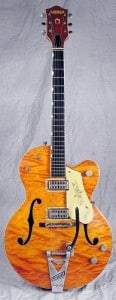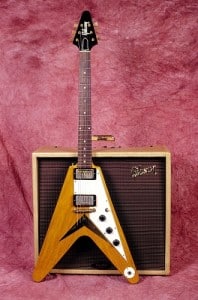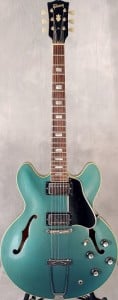by Alan Greenwood

Mankind has been strumming stringed instruments for more than 3,000 years. By the 1780s, after many evolutionary twists and turns (and dead ends) the guitar developed into the six-string Spanish-style instrument we recognize today.
As the guitar became more popular and ornate, people began to collect its various forms. For most of that time it was a hobby of the wealthy; however, beginning in the 1950s, two factors appeared which would ultimately drive guitar collecting to the level it enjoys today — baby boomers and rock and roll.
The size and affluence of the baby-boom generation changed just about everything in American and, as American cultural influence spread around the globe, the world. Rock and roll was one of its most profound cultural elements. And rock and roll meant the guitar. Suddenly, millions of teenagers with money to spend wanted to be rockers, and American manufacturers and marketers were very happy to oblige. The popularity of the guitar grew steadily over the late 1950s and early ’60s, then exploded to new heights when the Beatles hit the U.S., followed by the rest of the British Invasion rock acts. The boomer generation continues to be large and wealthy enough to collect things, and remains a force in guitar collecting. And, as the guitar continues to be the main instrument in most of today’s music, younger generations are joining in.

Whatever a person’s reasons for collecting guitars, they need to be aware of the potential pitfalls. Electric guitars have many components, and replaced or non-original parts can greatly affect their value. Many of the more popular models remained unchanged from when they first appeared on the market. Today’s Fender Telecaster looks exactly as it did when the model debuted in 1952. Many Martin acoustic models haven’t changed in decades. A huge part of guitar manufacturers’ current business is reissue models, for which they go to great lengths to replicate classic guitars of the past, typically employing period-correct details. To confuse matters even more, several brands offer new models that look like worn instruments, with “aged” parts and finishes. They are so good at it that most people would find it impossible to distinguish a reissue from an actual vintage guitar. Fortunately, there is a large amount of readily available information to help anyone better understand the various types and brands of guitars.
As with anything collectible, guitar values are driven by supply and demand. Prices are more stable for models that enjoy universal demand. Fender Telecasters and Stratocasters, Gibson Les Pauls, and Martin acoustics were often the most desired instruments when new, and that demand continues in the vintage market. As with the late-1950s Les Paul Standard, value can be greatly affected by the star players who used a particular model, but at the most basic level, valuable guitars are such because they were well-built. In the ’50s and ’60s, guitar builders, in an effort to meet heavy demand, flooded the market with inexpensive, poorly constructed instruments, but the serious musicians used the better stuff. You may want 1950s and ’60s Fender Stratocasters because Buddy Holly and Jimi Hendrix played them, but they played them because they were good instruments.
Special features on certain guitar models can affect value. When Fender introduced the Stratocaster in 1954, it was offered only in the standard sunburst finish. Within a few years, the company offered a selection of custom colors for an additional 5% charge. Today, “custom color” Strats from the ’50s can be worth twice as much as the standard sunburst. Changes in parts or finish can also have a significant impact on values. Though they look almost identical, the 1969 Martin D-45 with Brazilian rosewood back and sides is, at $38,000, almost six times more valuable than the 1970 model with Indian rosewood!

There are just as many factors that can lower the value of a collectible guitar. A refinished guitar may be very attractive, but its value will be lower (much lower in some cases) than one with original finish, even if is shows signs of wear or neglect. Non-original or missing parts will lower value. It is not unusual to see a guitar with replaced pickups and tuning gears. This may have improved the guitar in the eyes of the person who made the changes, but the vintage buyer is looking for original equipment. Plus, swapping parts often involves routing of wood or drilling new holes, further lowering value.
There are other, related areas to investigate. Electric guitars need amplification, and many old amps are very valuable. The most in-demand are vacuum-tube models of the 1950s and ’60s — early solid state amps usually didn’t have the desired tone — with smaller tube amps currently gaining popularity. Several current manufacturers continue to offer tube amps, often as reissues of their older models.
Your average electric guitarist has more guitar effects than anything else. These are devices that change the tone of an electric guitar in every way imaginable. While many early examples can fetch good money, values for most have not changed much over the years. As with amps, there are many companies producing reissue versions.
Guitarists have always dabbled in other stringed instruments. The mandolin is a staple in bluegrass and country, and is enjoying renewed interest with the recent boom of roots music. Certain mandolins from the 1920s and ’30s are very valuable.
Lap steel guitars were hugely popular in the 1930s, ’40s and ’50s. Retailers often sold lap steels with matching amps to students, many in cool art deco designs and pearloid finishes that today are collected as objets d’art. And, they take up less space than a collection of guitars. While some can get pricey, for the most part you could buy cool lap steels all day long for under a grand.
There has also been a renewed demand for ukuleles. Ukes share many attributes with the guitar, plus they require less space and are easier to learn. Many made from the ’50s to the present are little more than toys, but certain Martins from the 1920s are worth more than $15,000. Five hundred dollars to $1500 can get you many classic models and have you on the way to a great collection.

Many of the example values presented in this article are quite high, but the overwhelming majority of guitars are worth less than $1,000. Many are only worth a couple hundred dollars. One can get into guitar collecting at any level. You won’t have to be overly concerned with details if you are looking at just a few cheaper items to hang on the wall, but if you want to collect on a higher level, do your research and deal with well-established, reputable guitar dealers. The best way to maintain the investment you make is to buy the cleanest, most original examples you can find. A great place to start is at one of the many guitar shows held around the country. VintageGuitar.com lists all of them and publishes hundreds of articles on instruments like those discussed here.
Alan Greenwood is the publisher of Vintage Guitar magazine, which he founded in 1986. He is also the co-author of The Official Vintage Guitar Price Guide, published annually. Vintage Guitar also publishes several free e-mail newsletters of interest to collectors, and offers hundreds of archived articles about guitars and players on its website at www.VintageGuitar.com.
All photos by permission of Vintage Guitar magazine.
Hand Picking a Vintage Guitar Collection
-
- Assign a menu in Theme Options > Menus WooCommerce not Found





Related posts: